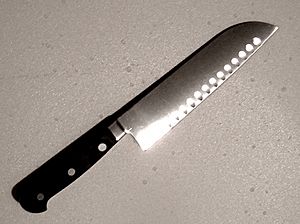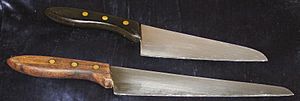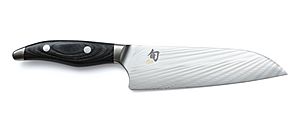Santoku facts for kids
The Santoku bōchō (which means "three virtues" or "three uses" in Japanese) is a popular kitchen knife from Japan. It's also sometimes called the Bunka bōchō. This knife is designed to be a great all-around tool for cooking.
Its blade is usually between 13 and 20 centimeters (about 5 to 8 inches) long. The edge of the blade is quite flat, and the tip curves down sharply, almost like a sheep's foot. The name "Santoku" refers to how useful it is. It can handle many different ingredients, like meat, fish, and vegetables. It's also good for many tasks, such as slicing, chopping, and dicing. This makes it a true multi-purpose knife for your kitchen! The Santoku's blade and handle are carefully made to balance each other perfectly.
Contents
History of the Santoku Knife
The Santoku knife was first designed in Japan. In Japan, people traditionally used different knives for different foods. For example, a Gyuto knife was for meat, a Nakiri knife for vegetables, and a Deba knife for fish. The Santoku knife was created in the 1940s to be a single knife that could do all these jobs well.
What Can a Santoku Knife Do?
The Santoku knife is known as the "Three Virtues" knife in Japanese. It's a fantastic all-purpose knife for your kitchen. You can use it for:
- Cutting: Slicing through various foods.
- Slicing: Making thin pieces of meat or vegetables.
- Chopping: Cutting ingredients into smaller bits.
How a Santoku Knife is Designed
The Santoku knife has a special blade shape called a "sheep's foot tip." This means the top edge of the blade curves down to meet the cutting edge. This design gives the Santoku a very straight cutting edge.
Unlike some Western chef's knives that are often used with a "rocking" motion, the Santoku is more about making a single, clean downward cut. When you chop an onion with a Western knife, you might slice down and then rock the tip forward. With a Santoku, you usually make one smooth cut from the heel (the back of the blade) to the tip.
Santoku vs. Western Chef's Knives
Santoku knives are usually shorter, lighter, and thinner than traditional Western chef's knives. They often use harder steel, similar to the steel used in Samurai swords. This harder steel helps the thin blade stay sharp for a long time.
- Length: A standard Santoku blade is about 6 to 7 inches (15 to 18 cm) long. A typical Western chef's knife for home cooking is often 8 inches (20 cm).
- Blade Angle: Most classic kitchen knives have a blade angle between 40 and 45 degrees. Japanese knives, including the Santoku, often have a sharper angle, around 12 to 15 degrees. This sharper angle makes them very keen for slicing.
- Hardness: Because Santoku knives have thinner, sharper edges, they use harder steel to keep that edge. However, very hard steel can sometimes chip if it hits something very hard, like a bone. Western knives use slightly softer steel, which is easier to sharpen but might not hold its edge as long.
- Features: Most Santoku knives don't have a thick part near the handle called a bolster. Many also have special "scallops" or hollowed-out sections on the sides, known as a Granton edge. These scallops help food fall away from the blade more easily and reduce friction when you're slicing.
Different Kinds of Santoku Knives
Some high-quality Santoku knives are made with a special technique called San Mai, which means "three layered" steel. This involves layering different types of steel together. Sometimes, these layers create beautiful patterns that look like flowing ink, called suminagashi. This layered steel makes the blade stronger and more resistant to rust, while still keeping a very hard and sharp edge. These knives are usually more expensive because of their quality and craftsmanship.
You might also see many knives made outside Japan that look like Santoku knives but have different designs, balance, or types of steel. Some of these copies also include the "scallops" or hollows on the side of the blade, just like the Granton edge. These small hollows create tiny air pockets between the blade and the food you're cutting. This helps the food separate from the blade more easily and makes slicing smoother.





